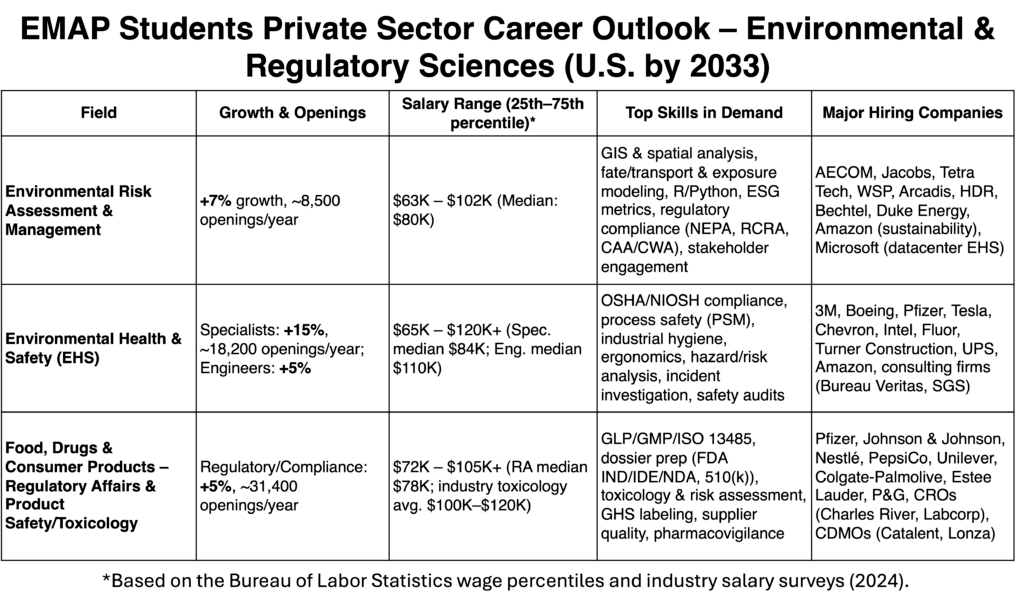Career Prospects for EMAP Students
Graduates of EMAP are expected to be especially competitive in multidisciplinary roles that require crossing science, regulation, and data science. The program’s rigorous training in authentic independent research also makes it a perfect segway to PhD studies. Compared to traditional environmental science M.S. programs, EMAP provides a stronger bridge into:
- Product stewardship & safety in industry (chemicals, foods, consumer goods, pharma)
- Regulatory affairs & compliance consulting
- Computational toxicology & AI-driven risk analysis
- Sustainability & environmental, social, & governance (ESG) data roles
Unique Interdisciplinary Knowledge and Skillset for Diversifying Professional Identity
When asked how studies with EMAP sustained her competitiveness on the job market and enabled her to carve out a successful career thus far, Natalie Ephraim who was an alumnus of class 2020 summarized succinctly: they equipped me with interdisciplinary knowledge and skillset to diversify my professional identity.
Whether studies with a tuition-based graduate program have a good return on investment depends largely on how good career prospects that the program can provide to its graduates. By this standard, EMAP has fared pretty well. EMAP has graduated five classes of a total of fifty-two students with zero attrition before 2025. All but one found satisfactory employments within 6 months after graduation: about 60% went to federal or local governments, 30% to private sectors or NGOs, 10% continued graduate studies for higher degrees (such as PhD). This is indeed because the EMAP’s well-integrated interdisciplinary and forward-looking curriculum, plus rigorous summer internship and independent research experiences that hone well students’ communication and critical thinking skills to bridge science and policy, have enabled its students to diversify their professional identity to remain competitive on the ever-changing job markets
Environmental pollutions in general and chemical contaminations in foods, drugs and consumer products in particular can be well regulated and mitigated only if they can be identified and quantified precisely. Using this as a guiding motto, EMAP educates and trains students to become proficient in measuring accurately & reliably both legacy & emerging pollutants in environment and chemical contaminants in foods and consumer products etc., and assessing their human health & ecological risks so that students can contribute effectively in real world to crafting, implementing, communicating, & assessing impactful environmental policies based on the soundest scientific evidence and balanced economic & societal analysis. Moreover, the forward-looking EMAP curriculum also positions its students well in employments in two emerging and potentially disruptive fields of profound practical importance: human health and ecological risk and foods, drugs, and consumer products safety assessments based on animal-test-less toxicology (i.e., so called new approach method-NAM) and artificial-intelligence-enhanced environmental protection.
Great Private Sector Job Outlook
In additional to federal and local government jobs, EMAP graduates are expected to compete well in a vast private sector job space that encompasses environmental risk assessment and management, environmental health and safety, and foods, drugs, consumer products safety assessment and regulatory affairs etc. Based on the 2024 US Bureau of Labor Statistics wage percentiles and industry salary surveys, the following table summarizes the US job outlook in that space up to 2033.

Some Representative Job Descriptions
Environmental Risk Assessor (Consultancy). Conduct multimedia environmental exposure and risk assessments for industrial clients; lead field sampling programs; perform contaminant fate/transport modeling; prepare technical deliverables supporting permitting and remediation; liaise with regulators and community stakeholders.
Environmental Health & Safety (EHS) Staff. Develop and maintain facility EHS management systems; implement OSHA PSM, LOTO, confined space, and fall protection programs; conduct hazard assessments; oversee incident investigations and corrective actions; support equipment/process design for inherent safety.
Regulatory Affairs Specialist (Pharma/Consumer Goods). Plan and prepare U.S. and international regulatory submissions; maintain registrations and licenses; ensure product labeling meets GHS/CLP; review product changes for regulatory impact; partner with R&D, manufacturing, and QA/QC teams; respond to health authority inquiries.
As to international students, likely similar job outlooks are expected in their respective countries as more and more countries are stepping up effort in the space of Environmental & Regulatory Sciences. For instance, US Food & Drug Administration, in partnership with European Food Safety Authority, created and leads the International Liaison Group on Methods for Risk Assessment of Chemicals (ILMERAC). ILMERAC currently has eighteen country members (Australia, Canada, China, Chile, Brazil, France, Germany, Greece, Italy, Ireland, Japan, Netherlands, New Zealand, Republic of Korea, Singapore, Spain, Switzerland, and US) and eleven observer organizations.
In summary, the Georgetown EMAP program pioneers a forward-looking and integrated graduate education and professional training of highest quality in several emerging interdisciplinary fields of great societal importance for future environmental sciences and policy leaders and practitioners, particularly in the fields of toxic substances measurement, risk assessment and management, policy making, workplace EHS, and regulatory affairs. They are expected to compete well in an ever increasing and also changing employment space that addresses directly the very long-term well being of human society and the planet earth. An added bonus for those who choose to study with EMAP is that a good understanding of environmental pollutants and associated health risks will likely help them lead a healthier personal life.
